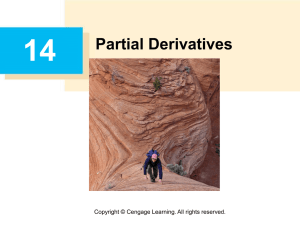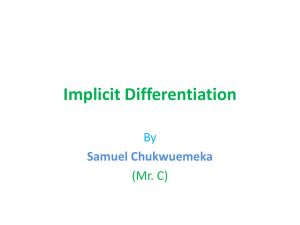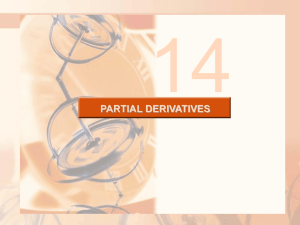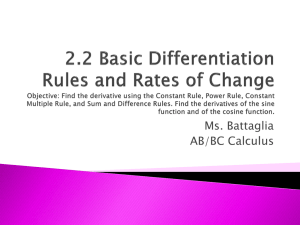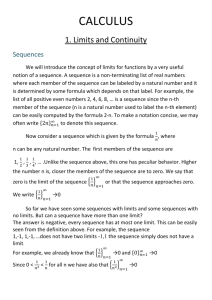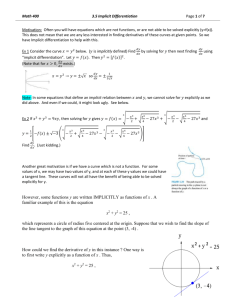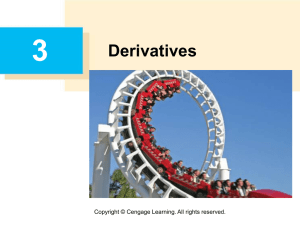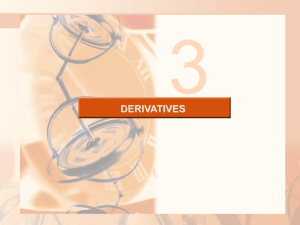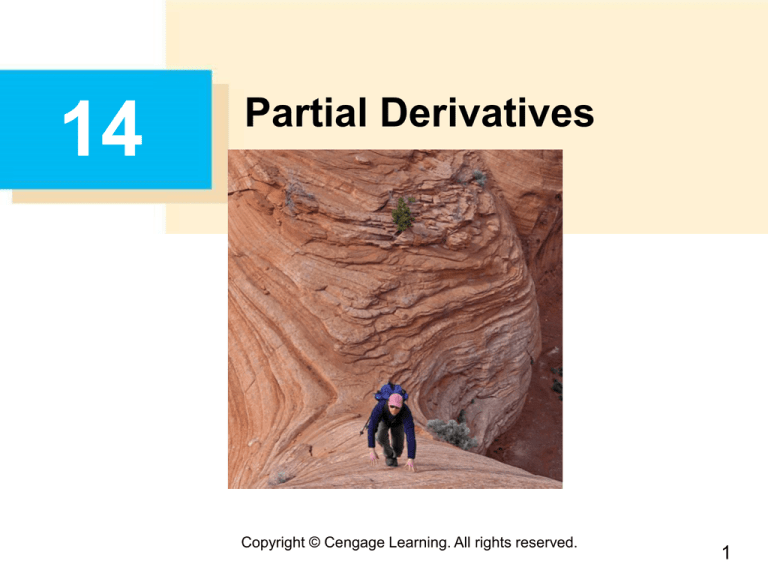
14
Partial Derivatives
Copyright © Cengage Learning. All rights reserved.
1
14.5
The Chain Rule
Copyright © Cengage Learning. All rights reserved.
The Chain Rule
Recall that the Chain Rule for functions of a single variable
gives the rule for differentiating a composite function:
If y = f(x) and x = g(t), where f and g are differentiable
functions, then y is indirectly a differentiable function of t
and
For functions of more than one variable, the Chain Rule
has several versions, each of them giving a rule for
differentiating a composite function.
3
The Chain Rule
The first version (Theorem 2) deals with the case where
z = f(x, y) and each of the variables x and y is, in turn, a
function of a variable t.
This means that z is indirectly a function of t,
z = f(g(t), h(t)), and the Chain Rule gives a formula for
differentiating z as a function of t. We assume that f is
differentiable.
4
The Chain Rule
Recall that this is the case when fx and fy are continuous.
Since we often write ∂z/∂x in place of ∂f/∂x, we can rewrite
the Chain Rule in the form
5
Example 1
If z = x2y + 3xy4, where x = sin 2t and y = cos t, find dz/dt
when t = 0.
Solution:
The Chain Rule gives
It’s not necessary to substitute the expressions for x and y
in terms of t.
6
Example 1 – Solution
cont’d
We simply observe that when t = 0, we have x = sin 0 = 0
and y = cos 0 = 1.
Therefore
7
The Chain Rule
We now consider the situation where z = f(x, y) but each of
x and y is a function of two variables s and t:
x = g(s, t), y = h(s, t).
Then z is indirectly a function of s and t and we wish to find
∂z/∂s and ∂z/∂t.
Recall that in computing ∂z/∂t we hold s fixed and compute
the ordinary derivative of z with respect to t.
Therefore we can apply Theorem 2 to obtain
8
The Chain Rule
A similar argument holds for ∂z/∂s and so we have proved
the following version of the Chain Rule.
Case 2 of the Chain Rule contains three types of variables:
s and t are independent variables, x and y are called
intermediate variables, and z is the dependent variable.
9
The Chain Rule
Notice that Theorem 3 has one term for each intermediate
variable and each of these terms resembles the
one-dimensional Chain Rule in Equation 1.
To remember the Chain Rule, it’s helpful to draw the tree
diagram in Figure 2.
Figure 2
10
The Chain Rule
We draw branches from the dependent variable z to the
intermediate variables x and y to indicate that z is a
function of x and y. Then we draw branches from x and y to
the independent variables s and t.
On each branch we write the corresponding partial
derivative. To find ∂z/∂s, we find the product of the partial
derivatives along each path from z to s and then add these
products:
11
The Chain Rule
Similarly, we find ∂z/∂t by using the paths from z to t.
Now we consider the general situation in which a
dependent variable u is a function of n intermediate
variables x1, …, xn, each of which is, in turn, a function of m
independent variables t1,…, tm.
Notice that there are n terms, one for each intermediate
variable. The proof is similar to that of Case 1.
12
The Chain Rule
13
Implicit Differentiation
14
Implicit Differentiation
The Chain Rule can be used to give a more complete
description of the process of implicit differentiation.
We suppose that an equation of the form F(x, y) = 0
defines y implicitly as a differentiable function of x, that is,
y = f(x), where F(x, f(x)) = 0 for all x in the domain of f.
If F is differentiable, we can apply Case 1 of the Chain Rule
to differentiate both sides of the equation F(x, y) = 0 with
respect to x.
Since both x and y are functions of x, we obtain
15
Implicit Differentiation
But dx/dx = 1, so if ∂F/∂x ≠ 0 we solve for dy/dx and obtain
To derive this equation we assumed that F(x, y) = 0 defines
y implicitly as a function of x.
16
Implicit Differentiation
The Implicit Function Theorem, proved in advanced
calculus, gives conditions under which this assumption is
valid:
It states that if F is defined on a disk containing (a, b),
where F(a, b) = 0, Fy(a, b) ≠ 0, and Fx and Fy are
continuous on the disk, then the equation F(x, y) = 0
defines y as a function of x near the point (a, b) and the
derivative of this function is given by Equation 6.
17
Example 8
Find y if x3 + y3 = 6xy.
Solution:
The given equation can be written as
F(x, y) = x3 + y3 – 6xy = 0
so Equation 6 gives
18
Implicit Differentiation
Now we suppose that z is given implicitly as a function
z = f(x, y) by an equation of the form F(x, y, z) = 0.
This means that F(x, y, f(x, y)) = 0 for all (x, y) in the
domain of f. If F and f are differentiable, then we can use
the Chain Rule to differentiate the equation F(x, y, z) = 0 as
follows:
19
Implicit Differentiation
But
and
so this equation becomes
If ∂F/∂z ≠ 0, we solve for ∂z/∂x and obtain the first formula
in Equations 7.
The formula for ∂z/∂y is obtained in a similar manner.
20
Implicit Differentiation
Again, a version of the Implicit Function Theorem
stipulates conditions under which our assumption is valid:
If F is defined within a sphere containing (a, b, c), where
F(a, b, c) = 0, Fz (a, b, c) ≠ 0, and Fx, Fy, and Fz are
continuous inside the sphere, then the equation
F(x, y, z) = 0 defines z as a function of x and y near the
point (a, b, c) and this function is differentiable, with partial
derivatives given by .
21

